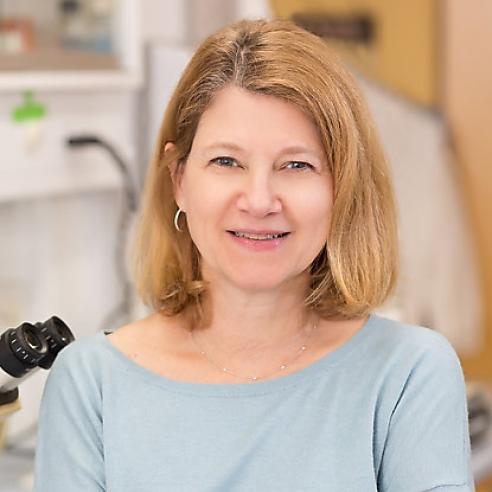RPB researchers are working to understand and prevent macular degeneration, to halt its progression, and to develop optical devices to offset vision loss. Each year, RPB dedicates hundreds of thousands of dollars to AMD research.
Age-Related Macular Degeneration
Click on the image, above, to watch RPB's online educational event, "RPB Lunch & Learn: Eye on AMD," featuring RPB-supported researchers giving an overview of AMD disease pathology and treatment options, as well as providing insight into new research directions.
Age-related macular degeneration (AMD) is a vision disorder caused by abnormalities in a portion of the eye's retina called the macula. Early symptoms of AMD are blurred central vision and a waviness of straight lines. The blurriness may progress to blind spots, affecting reading, TV watching and many other pleasures of independent living. There are two stages of AMD. Early AMD is far more common but late AMD has a far greater impact on vision.
Late AMD can be subdivided into the dry, or non-neovascular, form and the wet, or neovascular, form (see illustration). Dry AMD is characterized by more extensive pigmentary abnormalities in the macula and by a somewhat extensive loss of pigment cells and vision cells in the central macula. It is called dry because it is not associated with abnormal blood vessels or leakage of blood or fluid.
Click one of the video selections to view.
An estimated 1.75 million Americans over age 40 have decreased vision from AMD. That number is expected to increase to 3 million by 2020.
Wet AMD occurs in about 10% of patients who have late AMD. It is characterized by an overgrowth of blood vessels, behind the macula, that leak blood or fluid or both. This leads to damage of the vision cells. Age is the single greatest risk factor for macular degeneration. Leaky blood vessels under the macula can cause changes in vision. Studies supported by RPB show that lifestyle choices may influence the onset and progression of AMD.
Related News: Macular Degeneration

Research to Prevent Blindness and Association of University Professors of Ophthalmology Announce 2025 Recipient of RPB David F. Weeks Award for Outstanding Vision Research
Maria Bartolomeo Grant, MD, is recognized for ground-breaking contributions to the field of vision research.

Research to Prevent Blindness and Association of University Professors of Ophthalmology Announce 2024 Recipient of RPB David F. Weeks Award for Outstanding Vision Research
Patricia Ann D’Amore, PhD, MBA, is recognized for ground-breaking contributions to the field of vision research.

Research to Prevent Blindness Marks $400 Million in Funding to Advance Eye Disease Research
RPB funds a new round of researchers and hits a milestone in supporting vision-related breakthroughs.

RPB Funding Helps Researchers Revive Light-Sensing Cells in Organ Donor Eyes
This ground-breaking research accomplishment will open new doors for research on neurodegenerative diseases like AMD.

Recording available: RPB webinar on Dry AMD and Geographic Atrophy
RPB grantees provide expert insight on geographic atrophy and dry AMD as part of the "Lunch & Learn" series.

Join Us for AMD Awareness Month
Join RPB and Apellis Pharmaceuticals for a virtual event on Feb. 25 to learn about cutting-edge research into geographic atrophy and dry AMD.
Subscribe
Get our email updates filled with the latest news from our researchers about preventing vision loss, treating eye disease and even restoring sight. Unsubscribe at any time. Under our privacy policy, we'll never share your contact information with a third party.
| General Info | Grants | News & Resources |



